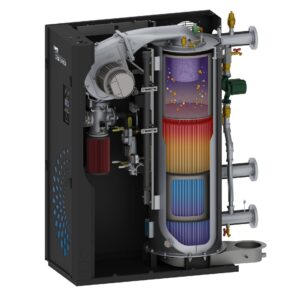Environmental concerns are a key element of college and university ESG initiatives. A study by EY-Parthenon found that 75% of 176 institution administrators surveyed said environmental sustainability is important to them, as well as to their stakeholders.
To satisfy sustainability benchmarks, stakeholders need to select high-efficiency water heaters, preferably from a manufacturer that shares their ESG vision. For example, some manufacturers are committed to sustainability efforts focused on pillars such as safety and regulation, water conservation, and energy efficiency. When decision-makers buy from these companies, their water heating systems can avoid producing thousands of metric tons CO2 while improving operating efficiency by as much as 10%.
Comprehensive View to Improve Efficiency
Decision makers need to consider more than the water heater specifications alone to achieve ESG goals. Understanding the application in which the water heater will be used is just as important to optimize performance. When misapplied, a water heater may not achieve peak performance. Considering the actual system load profile is critical, as most systems are oversized when initially designed. Facility managers can reduce BTH input by as much as 10% by installing high-efficiency condensing water heaters that match existing load compared to mid-efficiency models. As an added benefit, properly sizing the water heater lowers the system’s carbon footprint.
Broadening the focus to the entire system can also reap efficiency advantages. A combination plant that integrates space heating boilers with indirect heat exchangers and water heaters can further increase boiler efficiency by as much as 6%. This configuration also reduces total carbon footprint compared to two separate systems.
Other Design Considerations
Water heater advances can also aid in meeting sustainability objectives. Two examples are dual returns and O2 trim technology.
- Dual Returns
Circulation of hot water into the cold inlet on a condensing water heater lowers thermal efficiency. To offset this issue, some water heaters feature dual returns. They have a dedicated connection to building return loops to maintain two distinct temperature zones. Only the coldest water enters the lower condensing zone of the water heater during a firing cycle to increase efficiency. - O2 Trim Technology
Advanced combustion control systems in high-efficiency water heaters need to maintain precise air/fuel ratios to work properly and maximize efficiency. Environmental variations, such as humidity, atmospheric pressure, filter dust loading, and delivered gas energy content, can create problems in gas-fired water heaters. The result is inefficient operation, as water heaters do not achieve the ideal oxygen-fuel ratio.
There are other adverse effects if O2 levels are not optimized. If they are too low, unstable combustion can occur, which creates faults and increases unscheduled maintenance, adding to the lifetime costs of a water heater. Conversely, if O2 levels are too high, the dew point is lower and the water heater is less likely to condense, lowering efficiency.
Proper O2 levels can be achieved by water heaters with the O2 trim technology which creates the ideal environment for condensing to occur. Water heaters will have increased uptime reliability and efficiencies for cost savings, and lower emissions will also be achieved.
Advanced Communications and Controls
A Building Automation System (BAS) can help improve water heater efficiency. Water heaters now integrate advanced control technology to create multiple benefits by providing unparalleled capabilities from setup and configuration to maintenance and diagnostics. They streamline and simplify operation for more effective and efficient management of campus-wide domestic hot water systems.
Some advanced controllers come with integrated Water Heater Management (WHM) features that allow facility managers to easily sequence up to sixteen units to optimize system efficiency on the same system. By doing so, load requirements are met, and all water heaters in the system operate at maximum efficiency. The WHM monitors the fire rate of all water heater sequences by opening or closing the motorized valve, as required, to meet hot water demand. The result is the most energy-efficient and reliable water heating system design available.

Water Quality and Corrosion Resistance
Most of the United States is affected by hard water. Scale buildup is a main reason why water heaters become less energy efficient and ultimately fail due to the corrosive effects. Replacing water heaters prematurely or operating them at reduced efficiency will count negatively towards ESG goals. For this reason, decision makers must consider water heaters built with materials that can withstand corrosion. For example, duplex stainless-steel blends austenitic and ferritic steels to combine the advantages of 300- and 400-series stainless steel. The result is an extremely strong material that is highly resistant to aqueous corrosion in potable water at any temperature, as well as chloride stress corrosion cracking.
Facility managers should also consider treating the inlet water to control scale formation at the source. Water softeners are often used but may come with significant sustainability concerns related to water usage as well as harsh chemicals and salt released into the environment. An effective alternative are anti-scale systems that use Template Assisted Crystallization (TAC) technology. TAC controls the formation of scale in plumbing systems by transforming dissolved hardness minerals into harmless, passive microscopic particles without using salts or harsh chemicals and with no wastewater.
Materials Used Matter
Traditionally, the materials of construction for water heaters were always viewed with the eye on reliability and maintenance, as well as performance. While those remain staples and can aid in overall ESG initiatives by reducing waste, a new consideration can also be made. How are the materials made? For example, many water heaters utilize stainless steel, which is non-toxic and 100% recyclable. Some manufacturers go a step further and design water heaters with stainless steel that is from recycled materials. Other potential sustainable design efforts can include using outer shells made from recycled low-density polyethylene (LDPE) plastic commonly used for drinking bottles.
Sustainability efforts can also extend to the manufacturing process—which offers opportunities to use recycled items, such as cardboard, wooden pallets, and scrap metal—to shrink a manufacturer’s environmental footprint. Powder coat painting of units eliminates harmful VOCs that are found in spray or liquid paints, while using fiberglass without colorants is safer for the environment.
Conclusion
College and university administrators are implementing ESG initiatives, focusing on creating campuses that are sustainable and create an accepting and welcoming environment for students, professors, and others. Selecting the proper water heating equipment from a manufacturer equally committed to ESG will help achieve stated environmental goals.










